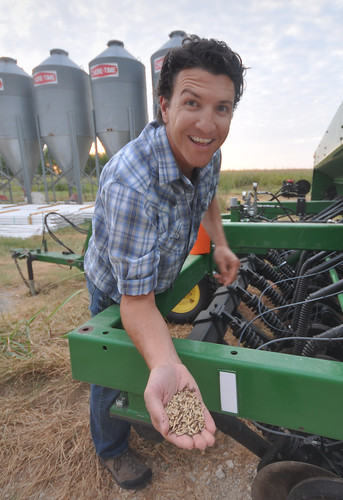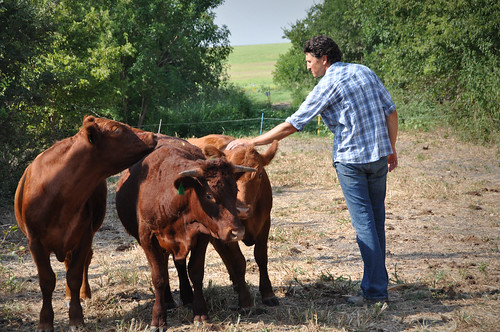
Jonathan Cobb says that with a new focus on soil health, "We got rid of all of the tillage equipment, and just dove in,” with cover crops. Photo: Ron Nichols.
NOTE: This week on the USDA Blog, we’ll feature the stories of America’s Harvest Heroes who, like farmers across the nation, are working this harvest season to secure the bounty of healthy food American agriculture is renowned for. From laying the foundation for the next generation of farmers putting down roots in rural America, supporting the fruit and vegetable growers who are helping to build healthier communities, bolstering new markets for the products of agricultural innovation, to harvesting renewable energy that is made in Rural America, with USDA’s support our farmers are yielding strong results for every American. For these reasons and more, America’s Harvest Heroes deserve our thanks.
Texas Producer Changes his Mind about Leaving the Farm
Jonathan Cobb had made up his mind. He was leaving the farm.
“I was disillusioned with farming in general because we were just pushing long days and chasing acres and it didn’t seem like there was very much reward,” Cobb said. “That quality of life was not very good. My wife was having to work a lot of hours full time and really support the family. Twenty-five hundred acres really didn’t support two families, and we weren’t living extravagant lifestyles by any means.”
Then came the drought of 2011.
“I thought, maybe this is a sign from God – maybe we shouldn’t be farming. Maybe we should move on to something else,’” Cobb said. “I was looking into moving down to Austin, Texas and being involved in some urban farming setups.”
In time, he and his wife Kaylyn put their house on the market and prepared to move, abandoning a century-old tradition of Cobb family farming.

Using diverse cover crops and diverse animal grazing, the Cobbs are building soil health on their farm. Photo: Ron Nichols.
Shortly after making that painful decision, Cobb’s father asked him to stop by and review some soil test results that had just arrived at USDA’s Natural Resources Conservation Service’s office in Temple, Texas. But before he could complete the chore, Cobb found himself “trapped” in a soil health workshop featuring NRCS’ Ray Archuleta and Willie Durham.
Too polite to leave, he took a seat on the front row. Within minutes, Cobb was entranced by what he was hearing from the presenters and the presentation he was seeing with his own eyes.
What he heard that morning from the soil health presenters rekindled a passion and love that conventional agriculture had nearly extinguished.
“By the end of the day I knew I was going to stay and be a part of the paradigm shift.” Cobb said.
Since that fateful day, the Cobb’s have downsized their farm from 2,500 acres to 450 and transitioned from row crops to cover crops with multi-species livestock grazing systems.
“We planted over a thousand acres of cover crops the very next year, got rid of all of the tillage equipment, and just dove in,” he says.
Cobb admits his farming operation is still evolving, but improving soil health remains the central goal.
“One very high priority is to help with the soil and building up the soil and the carbon in the soil,” he says. “We will probably make thousands of mistakes but we’ll learn along the way.”
Whatever happens, he says, “The goal is to build the soil.”
While Cobb’s new business model hasn’t fully evolved, he and his family are already reaping some of the intrinsic rewards he fondly remembered as a child growing up on the farm – like enjoying the smell of blooming clover in the evening and watching the sun rise on a warm summer day.
“If we can make a living and stay here then we couldn’t ask for anything more,” he says.
The United Nations General Assembly has designated 2015 as the International Year of Soils. USDA’s Natural Resources Conservation Service was founded as a result of the Dust Bowl of the 1930’s. For 80 years, the agency, originally named the Soil Conservation Service, has worked in close partnerships with farmers and ranchers, local and state governments, and other federal agencies to maintain healthy and productive working landscapes.

The Cobb’s have downsized their farm from 2,500 acres to 450 and transitioned from row crops to cover crops, like those seen here, with multi-species livestock grazing systems. Photo: Ron Nichols.
No comments:
Post a Comment
Note: Only a member of this blog may post a comment.